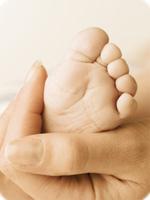These are suggestions for the best circumstances in which to massage your baby, however, you know baby best, and none of this is set in stone.
- First and foremost, babies, like adults, are sometimes not in the mood for a massage. The baby’s wishes should be respected. Prior to beginning any massage, permission is asked of the infant - “Do you want a massage?” or “Are you ready for a massage?” A parent need only watch the infant’s body language to know whether the infant is engaging or disengaging. For infants to be massaged, they must be in a quiet alert state. If the infant does not want a massage, or is fussy and uncooperative, then choose another time for the massage.
- The room should be comfortably warm, lit softly and perhaps play some soft music. These things will all be conducive to a relaxing massage. As for the time of day, you will know best when that will be. Before bedtime is a good choice as it will relax the baby in time for sleep.
- Massage can be done with or without oil, but if you choose to use oil, most massage therapists recommend grapeseed oil and sweet almond oil rather than traditional baby oil, which is mineral based. Plant-based oils are easily absorbed into the skin and easily digested if your baby sucks his thumb or fingers. Mineral oil is not good for the child to ingest.
- Basic strokes include a variety of movements. Strokes are usually long, slow and rhythmic, with just enough pressure to be comfortable but stimulating, as a gentle, firm touch. Make sure not to massage over the umbilical cord ending until it falls off naturally. While massaging the infant, you should smile and talk soothingly, maybe about how you are massaging his/her arms, legs, and tummy. The tone of your voice, more than anything, will interest and soothe the baby and build bonds of communication between you and your child. Massaging the legs, stomach, chest, arms, face, and ending with the back, is one sampling of a natural progression of massage for the infant.
Massage time is a great way to set up good communication with your baby through eye contact, touching, talking and singing. Once you set up times and a routine, massage time will be something you both look forward to and enjoy. If you would like to know more about how to do infant massage, below are some books on the subject.
Infant Massage: A Handbook for Loving Parents by Vimala Schneider McClure. Has step by step explanations with pictures for each move. It makes infant massage seem very easy. Great book with a lot of good information.
Touching: The Human Significance of the Skin by Ashley Montagu. Discusses the importance of touch to your infant.
No More Amoxicillin: Preventing and Treating Ear and Respiratory Infections Without Antibiotics by Mary Ann Block. The author is a licensed osteopathic physician who developed moves that she claims can treat and prevent ear infections without medicine. These moves are very much like infant massage moves.



